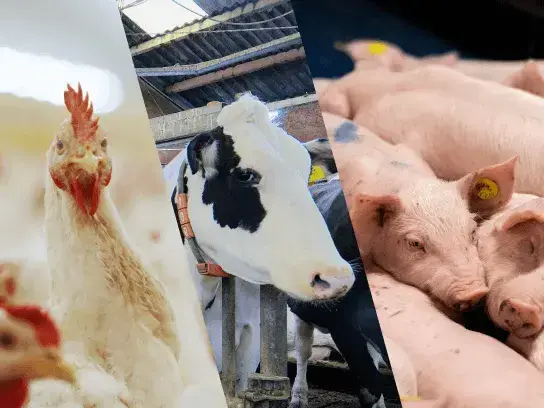- Poultry
- Laying Hens
- 3 minutes read
In an increasing amount of countries, a shift away from cage housing systems is becoming inevitable due to animal welfare regulations.
Aviary systems are considered to be the best alternative for cage systems. What they all have in common is that they are multi-tier systems that allow hens to move around freely throughout the house. Although this aims to improve animal well-being, it also comes with several challenges.
 With over 10 years of experience in aviary lighting, we know how lighting can help to overcome these challenges.
With over 10 years of experience in aviary lighting, we know how lighting can help to overcome these challenges.
The challenges of switching from cage- to aviary housing
Feather pecking
When feather pecking occurs, hens peck at the feathers of other hens, sometimes pulling the feathers out and eating them. It often occurs when they feel uncomfortable or stressed.
In cage houses, freedom to move is limited. Because of this, the hens are only able to interact with the other hens in their cage. In aviary systems, the hens have more room to move around, behave naturally and interact with all the other hens in the house. This increases the risk of pecking.
Feather pecking increases the amount of injuries and wounds. Since the red colour of blood and wounds further triggers pecking, it can even lead to cannibalism. Altogether, pecking decreases animal welfare and increases injuries & mortality rates.
Floor eggs
Floor eggs (2) can also be a serious problem. These are eggs that are laid outside the nesting area.
In cage housing systems, the hens have no other option than to lay their eggs in the nests inside their cages. However, as the hens are able to walk around freely in aviary systems, they can lay eggs wherever they want. This leads to a higher amount of floor eggs.
Floor eggs are considered to be second grade eggs, which are not as hygienic as eggs laid in the nesting place. Besides that, they have to be collected by hand, which costs more time. As a result, floor eggs decrease revenues and increase labour costs.
How can lighting help?
Now that we’ve had a look at the challenges that come with switching from cage- to aviary housing, let’s have a look at how lighting can help in overcoming them.
Reduce feather pecking
.webp?width=1800&height=783&name=From%20cage%20to%20Aviary%20lighting%20helps-02%20(2).webp)
1. Reduce stress
One of the main causes of feather pecking is stress. A lower amount of stress decreases pecking. Optimal lighting reduces stress by:
- Being flicker-free. Flickering lights increase stress. 100% flicker-free lighting is therefore highly recommended.
- Enabling deep and equal dimming. By making use of lights that dim both deeply and equally from 100-0%, the lights can simulate natural dusk and dawn. This simulation rather than a sudden change in light intensity will significantly decrease stress.
- Providing a broad light spectrum. A broad light spectrum improves the hen’s sight. By improving their sight, the hens become calmer. Besides that, better sight will improve their social interactions with other hens and their movement through the house. This eventually reduces stress as well.
2. Camouflage blood & wounds
Another way in which lighting can reduce pecking is by camouflaging blood and wounds. When pecking occurs, it is useful to mix white light with red light or even use red light monochromatically in extreme cases of pecking. Amongst others, this will camouflage the redness of the blood and wounds at which the hens are pecking. This way they are less noticeable by the hens, which reduces pecking.
Less floor eggs and stimulated feed and water intake
.webp?width=1800&height=783&name=From%20cage%20to%20Aviary%20lighting%20helps-06%20(2).webp)
1. Stimulate desired behaviour
By stimulating desired behaviour, floor eggs can be reduced. There’s more though. Even feed and water intake can be stimulated. An optimal light distribution and the correct light intensity play a key role here. How? By providing the right amount of light at the right place, desired behaviour can be stimulated.
Now, what does this look like in practice?
- Less floor eggs by making sure the nests are darker than the activity areas and by ensuring uniform light distribution below the system as well as in the aisles, the hens are encouraged to lay their eggs in the nests. Result: less floor eggs
- Stimulated feed- and water intake by making sure the feeding- and drinking areas are well-lit, feed and water areas can be found more easily. This way, feed- and water intake are increased.
Improving life through brightness
Time to wrap it up. A switch from cage- to aviary housing is becoming increasingly inevitable. Because of the fact that hens can move around freely in aviary systems, several challenges occur. Luckily, lighting can help. Feather pecking and floor eggs can be reduced, plus lighting is even able to stimulate feed and water intake?
Stay informed
Lighting matters. That's why we share our knowledge with the world through HATO Insights.
Pigs
Collaboration: How HATO Lighting and Optifarm Are Shaping the Future of Livestock
In modern livestock farming, success is no longer just about feed and shelter but about precision, insight, and care. That’s why HATO Lighting and Optifarm...
Pigs
How Optifarm is Transforming Livestock Farming with AI
In a world where agriculture is rapidly evolving, Optifarm stands out as a pioneer - bridging the gap between traditional farming and cutting-edge technology....
At HATO, we think high-quality lighting solutions, designed to enhance animal welfare and livestock production, must be accessible and affordable for all farmers.
Success Stories
Five Years, Zero Replacements: Why CORAX Is George Navaro’s Lighting of Choice
Herman Kusters: I would definitely recommend RUDAX

.webp)
.webp)





